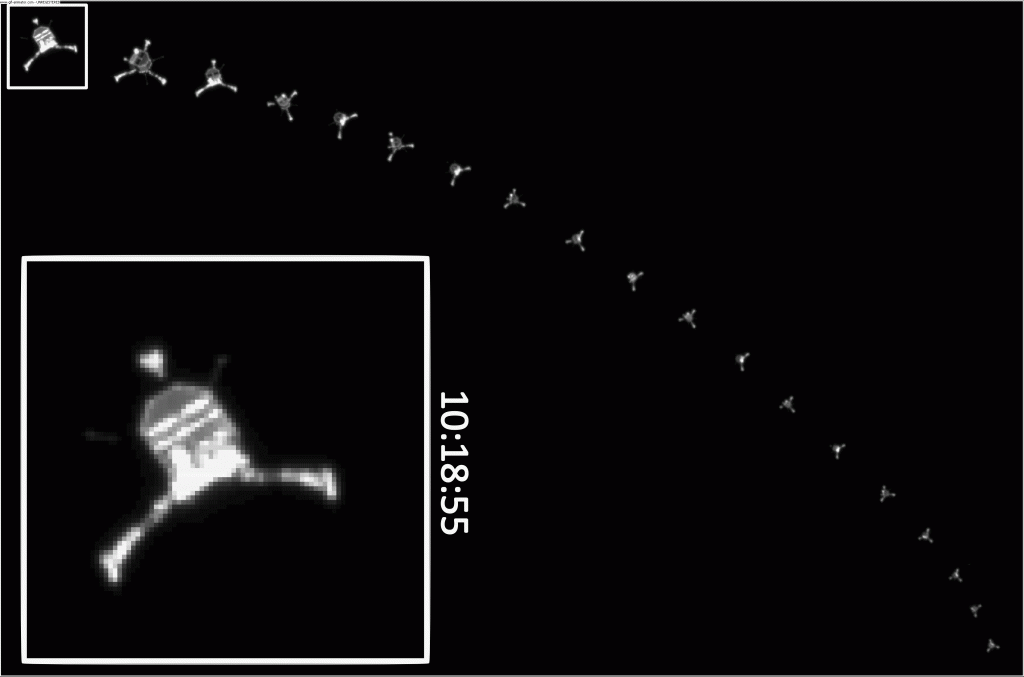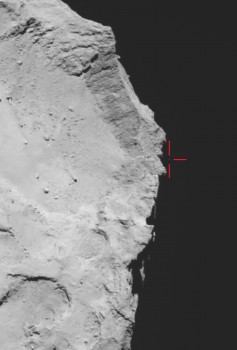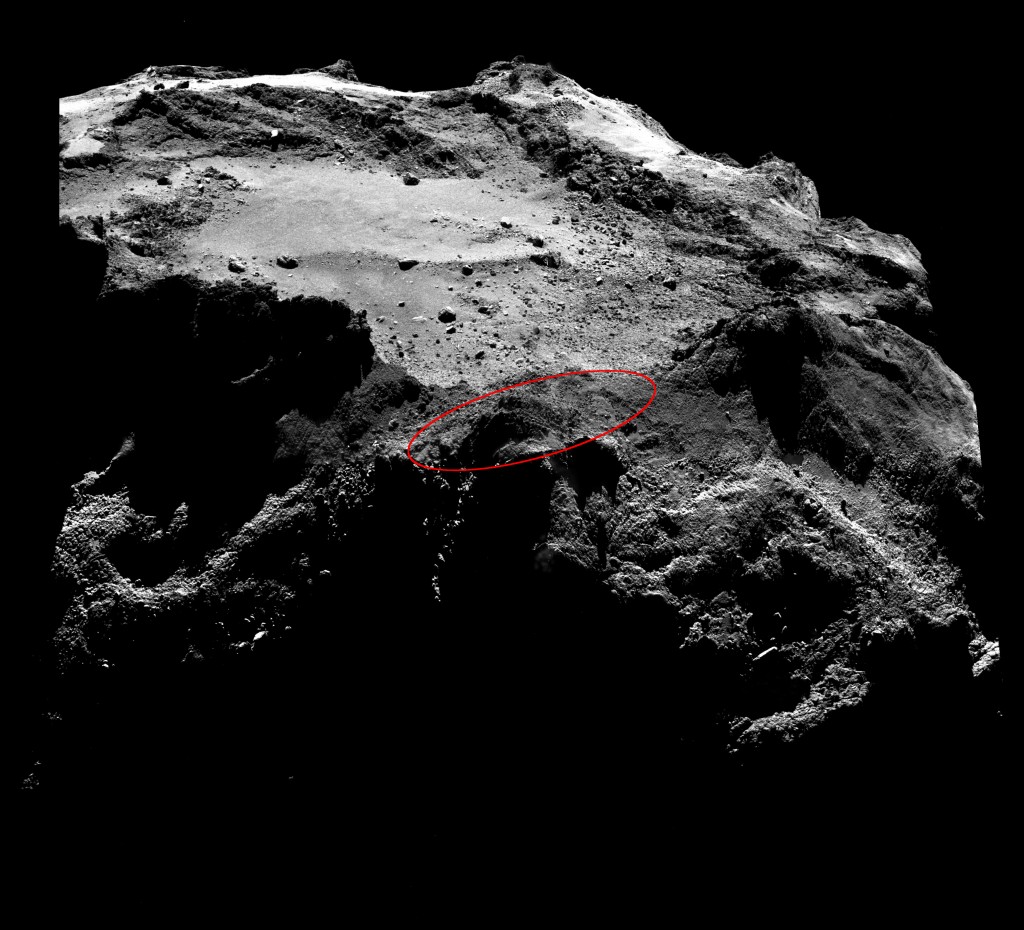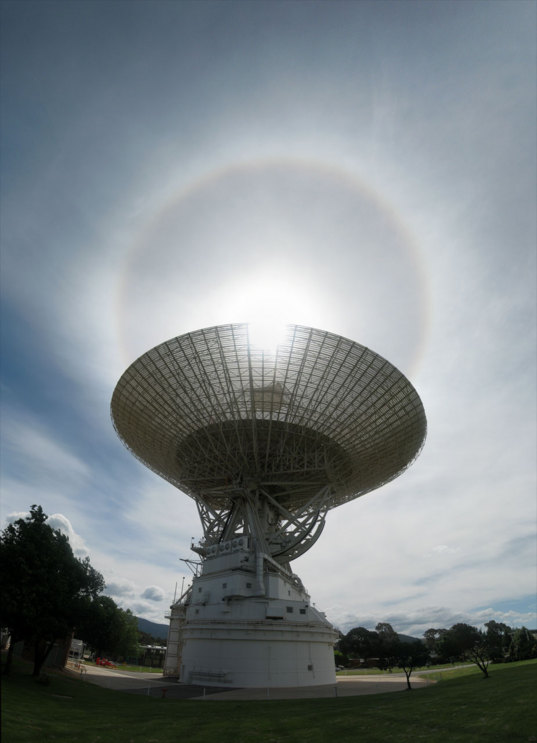These are the two most popular questions currently being asked of the mission – especially on our social media channels – and ones that we will try to answer in this post, including inputs from the OSIRIS team, and from the Lander Control Centre at the German Aerospace Center (DLR).
Where is Philae?
Ever since Philae touched down on Comet 67P/Churyumov-Gerasimenko for the final time on 12 November – it is thought to have come into contact with the comet’s surface a total of four times including the final landing – the search has been on to identify it in images. While the CONSERT instrument has helped to narrow down a 350 x 30 m ‘landing strip’ on Comet 67P/C-G’s smaller lobe, a dedicated search in OSIRIS images has so far not been able to confirm the little lander’s final location.

Click for animation! The timestamp marked on the images are in UT (onboard spacecraft time).
Credits: ESA/Rosetta/MPS for OSIRIS Team MPS/UPD/LAM/IAA/SSO/INTA/UPM/DASP/IDA
Philae’s descent to the surface, the initial touchdown at Agilkia at 15:34 UT (onboard spacecraft time) and first rebound were well-documented with the OSIRIS narrow-angle camera. The team also identified what they believe to be the lander in a wide-angle shot taken at 17:18 UT above the rim of the large depression – named Hatmehit – on the comet’s small lobe. The image has been used to guide subsequent lander search efforts, and provides the basis for trajectory reconstructions. According to data recorded by Philae’s ROMAP instrument, the lander may have grazed the surface at 16:20 UT – so this image may have captured the result of that encounter.

Philae above the comet? Rosetta’s OSIRIS wide-angle camera captured this view of Comet 67P/Churyumov–Gerasimenko on 12 November 2014 at 17:18 GMT (onboard spacecraft time).
Credits: ESA/Rosetta/MPS for OSIRIS Team MPS/UPD/LAM/IAA/SSO/INTA/UPM/DASP/IDA
Philae’s onboard data subsequently recorded the next touchdown at 17:25 UT and its final touchdown at 17:32 UT, at a site that has now been named “Abydos” (the first touchdown site remains as Agilkia). Images sent back by the CIVA imager onboard the lander and subsequent reconstructions are providing clues as to the nature of the landing site, but a visual confirmation is still required to confirm its location.
Follow-up dedicated OSIRIS imaging campaigns that took place in late November and December from distances of 30 and 20 km from the centre of the comet (about 28 and 18 km from the surface, respectively) have not been successful in locating the lander. The campaigns specifically targeted the times that the lander would be illuminated – it is illuminated approximately 1.3 hours per comet revolution – and that Rosetta had the correct orbital position to be able to image it. However, the cameras were looking into long cast shadows from Rosetta’s terminator orbit, perpendicular to the Sun direction, which does not provide the optimum conditions for detecting the lander.
It is also important to note that Rosetta’s trajectory immediately following Philae’s touchdown allowed for good viewing conditions at the original landing site. Now that Rosetta has moved to a different orbit, and is further away from the comet, the chances of observing the lander are less (watch this video for a recap of the different trajectories following the landing).
The image below is an example of the images being used to search for the lander; it is a slightly cropped 2 x 2 mosaic taken by the OSIRIS narrow-angle camera on 13 December 2014 from a distance of about 20 km to the centre of the comet. For the 20 km imaging run 18 sets of two images were taken – one each with orange and blue filters to take advantage of the reflection of the lander solar panels, which differ compared to the cometary environment. The images were taken in the 2 x 2 rasters to ensure good surface coverage. The lander, about 1 metre across – the size of a household washing machine – would measure only about three pixels across in these images.
“We’re looking – by eye – for a set of three spots that correspond to the lander,” says OSIRIS principal investigator Holger Sierks from the Max Planck Institute for Solar System Research (MPS) in Germany. “The problem is that sets of three spots are very common all over the comet nucleus; Hatmehit and the area around its rim where we’re looking is full of boulders and we have identified several sets of three spots.”

Lander search area. The image is a 2 x 2 mosaic comprising OSIRIS narrow-angle camera images taken on 13 December 2014 from a distance of about 20 km to the centre of the comet. Credits: ESA/Rosetta/MPS for OSIRIS Team MPS/UPD/LAM/IAA/SSO/INTA/UPM/DASP/IDA
Although Rosetta is flying to within 6 km of the comet’s surface on 14 February, the planned trajectory foresees the closest approach on the lower part of the larger comet lobe (although the trajectory also takes Rosetta over the first touchdown point). This trajectory is planned such that the Sun will be directly behind the spacecraft, allowing the acquisition of shadow-free images. The close flyby will also allow the suite of science instruments on the orbiter to take spectra of the surface with unprecedented resolution and to directly sample the very innermost regions of the cometary coma in order to learn more about how the comet’s characteristic coma and tail develop.
“Rosetta’s busy science schedule is planned several months in advance, so a dedicated Philae search campaign was not built into the plan for the close flyby,” says ESA’s Rosetta project scientist Matt Taylor. “We’ll be focusing on “co-riding” observations from now on, that is, we won’t be changing the trajectory of Rosetta to specifically fly over the predicted landing zone in a dedicated search, but we can modify the spacecraft pointing and/or command images to be taken of the region if we’re flying close to the region and the science operations timeline allows.”
“After the flyby we’ll be much further away from the comet again, so are unlikely to have the opportunity for another dedicated lander search until later in the mission, maybe even next year,” adds ESA’s Rosetta mission manager Fred Jansen. “But the location of Philae is not required to be able to operate it, and neither does it need to be awake for us to find it.”
When will Philae wake up?

The likely orientation of Philae, shown in a visualisation of a topographic model of the comet's surface. Credits: ESA/Rosetta/Philae/CNES/FD
For those of you who followed the wake-up of Rosetta, you will know that it is not simply a case of switch on and get back to the science right away. The same goes for Philae.
At the original landing site, Philae was expected to receive around 6.5 hours of illumination per 12.4 hour comet day, with temperatures becoming too high by March 2015 to enable continued operations. Now, at its new location, the illumination is just 1.3 hours.
“Now we need the extra solar illumination provided by the comet’s closer proximity to the Sun by that time in order to bring the lander back to life,” says DLR’s Lander Project Manager Stephan Ulamec.
In fact, even by May, the Sun inclination will be such that it will be directly overhead of the predicted landing zone, although the lander’s orientation is such that it won’t be able to make full use of the maximum illumination on offer.
As for the process of wake up, and assuming Philae survived the low temperatures in its new residence, the earliest that the lander team expect it to be warm enough to boot up is in late March. But it will likely be May or June before there is enough solar illumination to use its transmitter, and to re-establish a communications link with Rosetta – the lander needs about 17 Watts to wake up and say “hello”.
Furthermore, the orbiter also has to be commanded to listen for Philae’s “I’m awake” signal, and be in a good position relative to the landing site to pick up the signal – although it can be up to 200 km away from the comet. It will be longer still before the battery is fully charged and Philae is ready to do science again, but that means there is a chance it will have a ringside seat for perihelion.
“We are already discussing and preparing which instruments should be operated for how long,” adds Stephan.
But even if Philae doesn’t wake up, it’s important to remember that it already completed its first science sequence on the comet, unexpectedly providing information from multiple locations on 67P/C-G.
Meanwhile Rosetta will continue to follow the comet on its orbit around the Sun and as it heads back towards the outer Solar System.
![]() for biomedical purposes.
for biomedical purposes.













